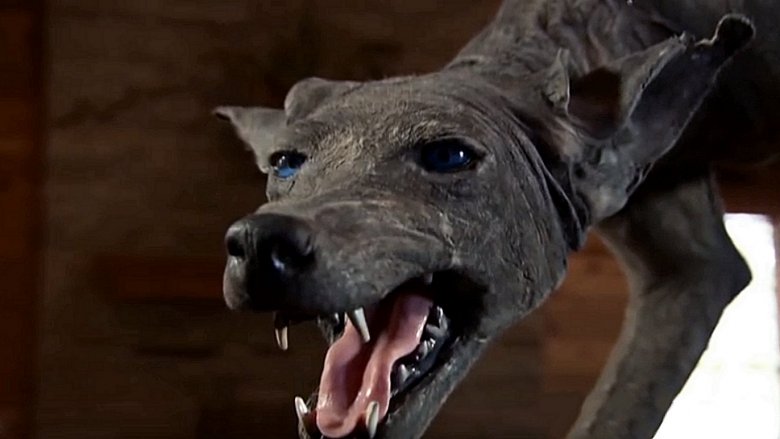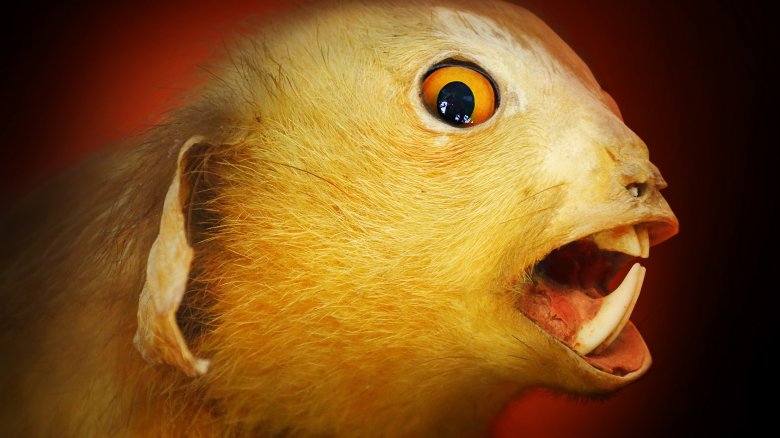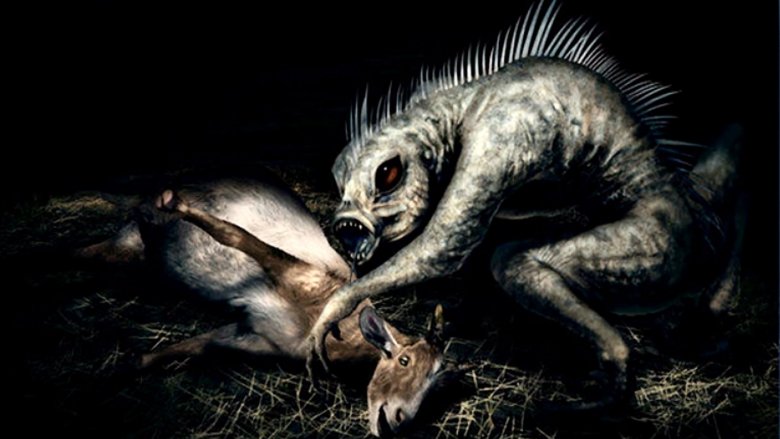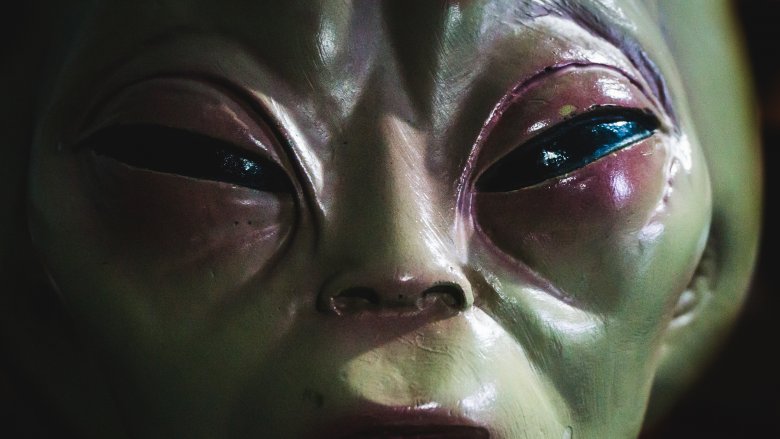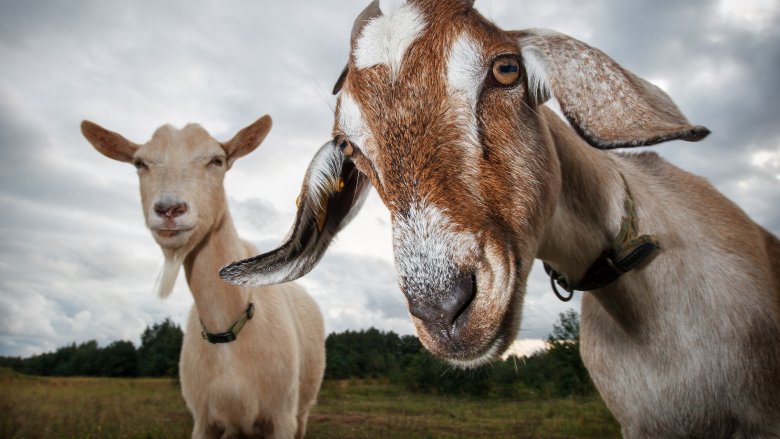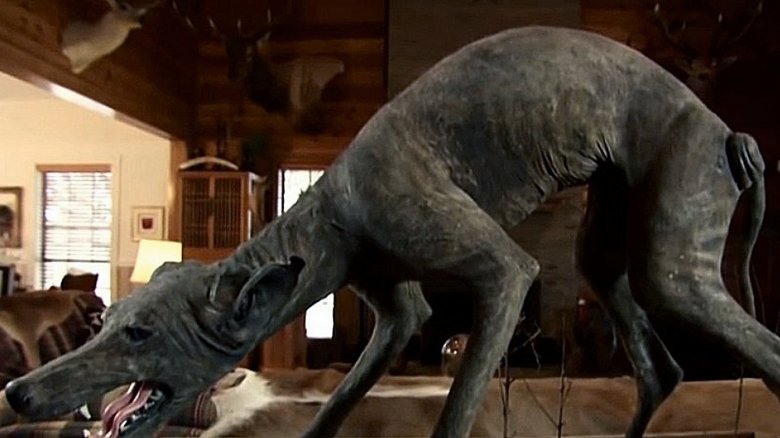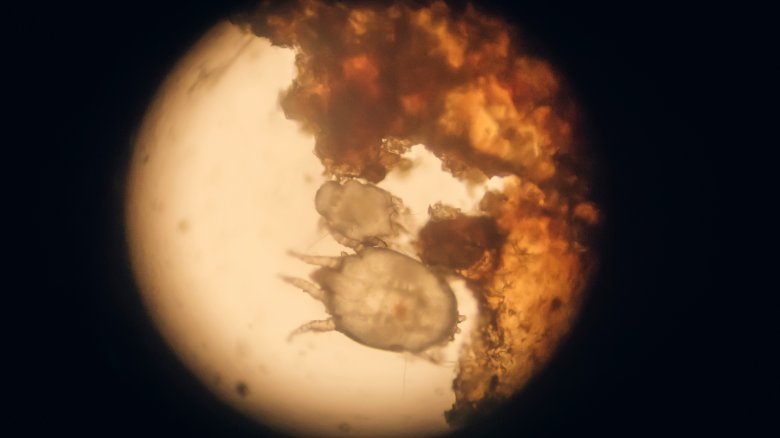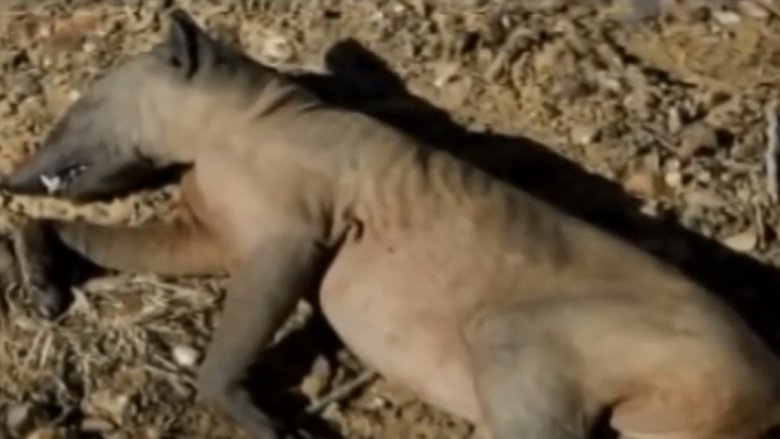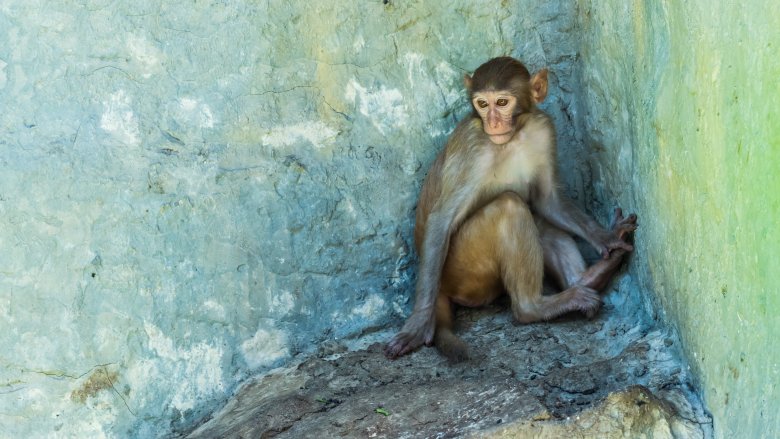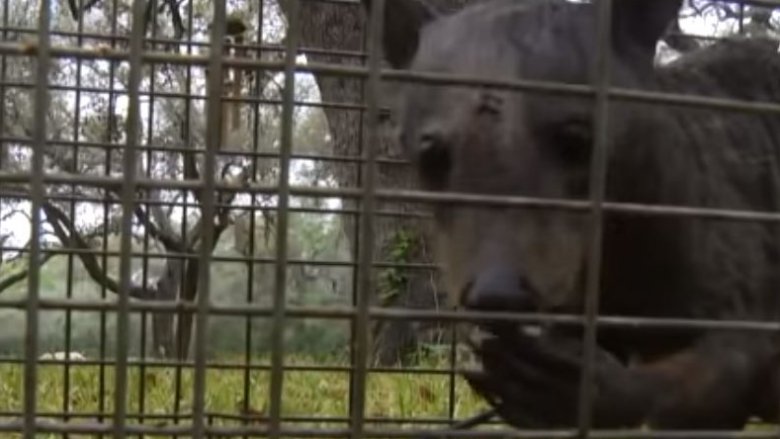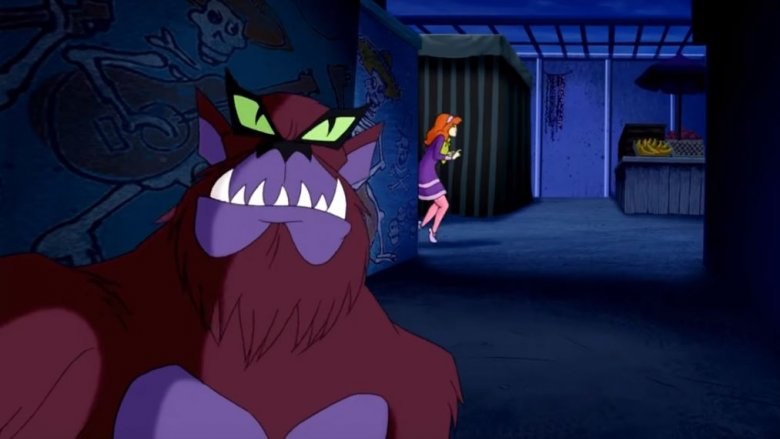The Creepy Truth About The Chupacabra
While there might be a number of modern mythological beasts stalking our woods, mountains, oceans, and rivers, most of them don't have sinister intentions. Sure, it'd be scary if Nessie poked her head over the water, or if Bigfoot wandered into your yard. But honestly, the worst thing a big ape is going to do is accidentally topple your mailbox, or maybe stare into your windows.
The chupacabra, on the other hand? Yikes. Those things are vicious. Known for ripping out the throats of livestock and draining out their blood, these vampiric "goat suckers" have been accused of ruining the day for countless farmers throughout Latin America, as well as the southwestern United States. Surprisingly enough, the real scientific explanation behind the whole chupacabra myth is even creepier than the legend, particularly if flesh-eating mites make you uncomfortable. Before getting to that part, though, let's start back at the beginning.
Chupacabras are the newbies of the monster world
Most of the monsters people talk about today are drawn from old legends, but oddly enough, the chupacabra has no such deep roots. Though an old New York Times piece refers to strange livestock attacks that took place in the 1970s, it wasn't until 1995 that "chupacabra" sightings really became a thing, and it all started in Puerto Rico. According to what chupacabra expert Benjamin Radford told ABC News, the creepy little monster was first spotted by a Canóvanas resident named Madelyne Tolentino. In an Alibi interview, Ms. Tolentino described the creature that she saw as being 3 feet tall, bipedal, and humanoid. It had distinctive spines running across its back, long slender fingers, and no genitals.
Anyway, Tolentino's sighting made the local TV news, and the story went viral across Puerto Rico. Not long afterward, Animal Planet says hundreds of heads of livestock were slaughtered, right there in Canóvanas. The problem got so bad that Mayor Jose "Chemo" Soto spent the next year hunting for chupacabras with an armed militia, week after week. Spoiler alert: They never found anything. However, chupacabra attacks and sightings migrated across the island, as areas like Orocovis and Torrecilla Baja were forced to deal with mass-murdered sheep, chickens, guinea pigs, and even a cat whose genitalia was removed. The local issue soon spread to the mainland, as chupacabra sightings popped up in Florida. A new legend had been born.
There are two extremely different 'types' of chupacabra
Here's one particularly bizarre feature of the chupacabra, when compared to its more consistent cryptid cousins: There are two versions, and pretty much the only thing they have in common is a taste for the blood of domesticated animals. Most of the early chupacabra sightings, as documented by the New York Times, lined up closely with Tolentino's description of a humanoid reptilian, often with glowing red eyes, a long forked tongue, and the distinctive array of spines across its back. Early believers tended to think of the chupacabra as an alien life-form, an abomination, maybe even a demonic entity, rather than simply a carnivorous animal.
These days, when you hear "chupacabra," you probably picture a lanky, sharp-toothed canine, which tends to walk on four legs and is usually hairless, but certainly not scaly. As time went on, a lot of the X-Files-type associations have also largely fallen by the wayside, as more people came to believe the chupacabra might just be an undiscovered animal. As BBC explains, the concept of these dog-like chupacabras seems to have replaced the original, bipedal creature sometime in the 2000s, probably right as the stories were gaining more popularity. Though both versions might share the same taste in food, they probably wouldn't like each other too much.
It's a Latin American monster (mostly)
Every monster has its own stomping grounds, and if the chupacabras did speak a human language, it would definitely be Spanish, or maybe an indigenous South American tongue. For the most part, these hypothetical bloodsucking predators seem to prefer hunting for goats in Latin American countries and territories, and even when they creep up to the United States, they're more likely to be spotted in southern border states like Texas and Arizona. Chupacabra stories are even told all the way down in South America, and the Spanish newspaper ABC reported on a supposed chupacabra corpse being found in Paraguay.
Probably part of this is just because when people claim to see strange woodland monsters in Canada and the United States, they don't think chupacabra — they think Sasquatch or maybe the Jersey Devil. However, chupacabra sightings do sometimes occur in weird locations. As ThoughtCo points out, there have been sightings as far north as New Jersey and Michigan, and one report even came from all the way in Warwickshire, England. Kinda hard to imagine one of these toothy beasts sneaking onto an airplane, isn't it? However, the story has spread even further. At one point, an unidentified animal in China was claimed to be a captured chupacabra, before it was actually found to be an albino civet cat, according to People's Daily Online.
There are some crazy theories
Let's presume for a moment that the chupacabra is real, and that it's not just some misidentified wild animal. If so, what is it? Where did it come from? Some of the theories about the chupacabra's origins are seriously wild. As the Center for Inquiry explains, the two most popular UFO-inspired explanations for the chupacabra are that it's either an alien creature dropped on Earth (presumably for extraterrestrial amusement) or that it's the result of some weird science experiment by NASA. Who knows why NASA would be genetically engineering bloodsucking monsters instead of, you know, building rocket ships, but hey, that's the theory. The NASA "Frankenstein" notion grew popular enough that, according to Animal Planet, NASA spokesman Brian Welch was forced to publicly deny the theory, groaning that, "Before this it was the face on Mars, and before that it was modifying the weather, before that we were beaming radiation from satellites to make people impotent" and so on. Apparently, you can only deny conspiracies so many times before all the fun is sucked out of it.
The bizarre origin stories don't end there. Some claim the Chilean military discovered chupacabra eggs, and Benjamin Radford has discussed how the disaster caused to Puerto Rico by Hurricane Hugo in 1989 is often tied to the goatsucker's supposed "escape." Probably the weirdest theory, as described by ABC, is the belief that HIV and AIDS were caused by the chupacabra's vampiric tendencies.
The name 'Chupacabra' was hotly debated
As you probably know, the Spanish name "chupacabra" translates to English as "goat sucker," referring to this cryptid's unpleasant habit of sucking blood out of livestock. However, because the chupacabra wasn't even recognized as a creature, real or fake, until the 1995 incidents in Puerto Rico, its name is a modern invention. According to Professor Reinaldo L. Román of the University of Georgia, it seems likely that this distinctly monstrous name was coined by — of all things — a comedian, Silverio Perez. Not everyone was so thrilled about the ghastly moniker, though. UFO investigator Jorge Martin pushed for the creature to be renamed EBAS, a Spanish acronym meaning "Alien Biological Entities." Unfortunately, acronyms are never as catchy as a good horror movie-style label, so "chupacabra" won the battle.
Somewhat amusingly, it seems like the name "chupacabra" actually predated the violent sightings. ABC News says the term appeared in a 1960s episode of Bonanza, though it was used in reference to a type of bird that supposedly sucked milk from nursing mama goats, i.e., "goat sucking." Not quite so creepy as the chupacabra everyone knows today.
The Highland Park 'hoax'
If you were stalking the internet back in the good old days of yore — aka the 2000s, way before the MySpace reference in Iron Man became outdated — there's a good chance the name "chupacabra" brings back memories of a certain nightmarish photograph, taken in Los Angeles, which seemed to show the terrifyingly realistic head of a chupacabra having been severed, held up, and mutilated by some kid with a stick. Remember the one? If you weren't horrified by the thought that the chupacabra was real, you were horrified by the grotesque animals rights abuses depicted in the photo.
As it happens, this photo was never supposed to be a hoax, even though it became one. The image was actually the creation of an artist named Charlie White, pictured above. He referred to this particular image as "Highland Park," and it belongs to a photo series called "In a Matter of Days." According to Snopes, White's photo series was intended to depict an array of "accidental" encounters with monsters in Los Angeles, symbolizing moral decline within Western civilization. Yes, you were supposed to feel bad for the mutilated chupacabra in the image, as White's concept was based on making these horrific monsters seem less horrific than the humans.
The Texas Blue Dog sightings
In 2007, a Texas nutritionist named Phylis Canion was struck by a chupacabra problem, according to the Huffington Post. Despite her best efforts, Canion's ranch kept getting raided by an unseen predator that killed 28 of her chickens, ripping out their throats. Sound familiar? One day, Canion stumbled upon a profoundly weird, dog-like corpse on the side of the road. The dog's body had tough, hairless blue skin, steel blue eyes, only three toes on each foot, a pronounced overbite, and strange pouches on both sides of its tail. The Texas rancher was pretty sure she'd just discovered a chupacabra, so she brought this "Texas Blue Dog" home, had it stuffed by a taxidermist, and now keeps it in her living room.
She also tested it, and according to Canion, the Blue Dog came out as a hybrid of a coyote and a Mexican wolf. An array of similar-looking Texas Blue Dogs popped up around the state. A local Houston news station asked animal control expert Claude Griffin about the matter, and Griffin said people in the area were specifically inbreeding different types of canine for the sheer purpose of letting them go, catching them, and claiming they'd found a chupacabra. So yes, the Blue Dogs were real, and yes, they were canines. But here's the interesting thing — just because these animals were canines, it doesn't mean they weren't also "chupacabras," because...
The real chupacabras
Ever heard of scabies? Hey, stop scratching. Stop. Stop. Also known as the "seven-year itch," scabies is caused by little flesh-eating mites, and while it seriously sucks to have them as a human being, they're a lot worse for canines. When the mites get under a dog or coyote's skin, they cause a condition called mange, which is not only intensely itchy for the poor pups, but also causes severe hair loss, turns their skin into a thickened black/red mess, and eventually kills them. Horrifying stuff. And as if the scabies mites weren't horrible enough, research has determined they're also most likely the real cause of all this chupacabra business.
As BBC explains, real-life "chupacabras" are actually canine mammals, particularly coyotes, who come down with severe mange and start preying on livestock. How is this confirmed? Because anytime a dead chupacabra pops up after a rash of farm killings, tests show that these weird-looking creatures end up being canines with mange. It's surprisingly depressing, but it makes a lot of sense.
But wait, why would coyotes rip out goat/chicken/sheep throats and drink their blood? Well, for one, all that vampirism stuff is an exaggeration. LiveScience explains that whenever chupacabra victims are autopsied, there's always plenty of blood left in the body. As for the whole "ripping throats out" thing, the Texas Natural Resources Server explains that this attack isn't actually that unusual a behavior in predatory mammals. So yeah, chupacabras are real. They just aren't their own species.
Chupacabras are like cryptid extraverts
As fun as it is to trade Bigfoot stories over a few beers, every cryptozoology fan knows how every conversation gets ruined by that one skeptic with the great point: "If [insert animal] is real, why is there no good evidence, no dead bodies, no stool samples?" That's what makes the chupacabra so unique among its monstrous brethren, as described by Chupamacabre.com. Evidence pops up all the time. Even though dead "chupacabras" always end up being coyotes with mange, the sheer regularity with which they appear — and are labeled as chupacabras — has made this kinda/sorta real creature into something of a mascot for the cryptozoological world.
For example, The Telegraph reported in 2009 that a chupacabra body was found in Texas, just two years after Texas State's University news service reported a similar discovery. ABC News reported another one in 2014. In 2008, another was reportedly found in the Dominican Republic. The list goes on. These days, canines with mange are often just reflexively referred to as chupacabras, sort of like how "Google" and "Xerox" became verbs, or how some people just call all tablets "iPads." But in all this modern chupacabra hoopla, there's just one piece of the puzzle that's unresolved: What happened to the original reptilian, bipedal chupacabra?
Where did the original chupacabra go?
The world will never know if the original chupacabra sightings were real, but if they were, that 3 foot humanoid creature with the spines and red eyes probably wasn't a canine. What could it have been? Speaking to National Geographic, famed cryptozoologist Loren Coleman points out that the reptilian, spiny-backed descriptions from those early sightings sound eerily similar to the monster in Species, that sci-fi/horror film starring Natasha Henstridge as a sex-crazed alien. What makes this significant is that Species opened in Puerto Rico right before the chupacabra incidents started, and easily could have informed people's imagination.
But what if Madelyne Tolentino did see some long-limbed creature scampering around? Coleman has an explanation for that, too, stating that a number of rhesus monkeys were being experimented on in Puerto Rico at that time. Perhaps a few of them escaped. It sounds weird, but if you close your eyes and imagine one of these creatures scampering around at night from a distance, it makes sense.
Whether you believe in the original chupacabra or not, some of the more recent sightings have resembled the old-school monster more than the canine version. For example, CNET shared a purported video of a bipedal "chupacabra" walking through Portugal. So here's a silly theory: Maybe the original chupacabra just retired back in 2000, flew off to Europe, and let those poor coyotes take the blame for its violent history. Maybe it'll make a comeback someday.
The family that had a Chupacabra named Chupie
In 2014, the Independent wrote that Bubba and Jackie Stock of Ratcliffe, Texas, had captured what they described as a "baby Chupacabra" walking through their yard, and they were keeping it on their property in a cage, supplying food and water. Their neighbor, Arlen Parma, concurred with the couple's assessment. To answer your first question: Yes, the animal was real, as photo/video evidence proves. As for your second question, no, it wasn't some mythical beast. According to the experts, this was once again a case of a fox, dog, or coyote afflicted with severe mange.
Anyhow, the couple wasn't sure what to do with the animal, which they named "Chupie," particularly once animal rights groups protested their decision to keep it in a cage. Sadly, the Independent followed up on the story a few days later to report that Chupie's painful, scabious condition had greatly worsened to the point where the Stock couple had decided to euthanize the poor animal based on the advice of a local game warden.
The Chupas hit pop culture
Just as the urban legend of the chupacabra was probably influenced by science-fiction and horror films, the cryptozoological creature itself has gone on to inspire its own wave of films, TV appearances, merchandise, coffee mugs, T-shirts, and just about anything else a blood-sucking monster could want, short of more livestock to viciously slaughter. For example, there have been a number of schlocky B-movies featuring the infamous goat sucker, including Chupacabra Terror (2005) and Chupacabra vs. the Alamo (2013), which features a pack of chupacabras swarming some people holed up in the Alamo. The X-Files, of course, tackled the myth in their own way, and both Scooby Doo and South Park spoofed the whole thing. Meanwhile, "Ravenous Chupacabra" is a card in Magic: The Gathering, and if you ever visit Asheville, North Carolina, you can stop in at a Latin café named Chupacabra. No goat blood on the menu, but they do serve goat cheese.
Because of all this media attention, the chupacabra has become almost as recognized by the general public as old standbys like Bigfoot and the Loch Ness Monster, which is no easy feat. Good job, chupas!
